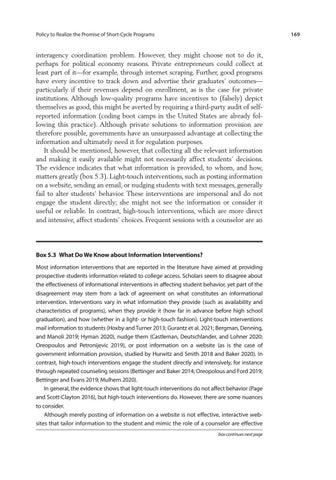169
Policy to Realize the Promise of Short-Cycle Programs
interagency coordination problem. However, they might choose not to do it, perhaps for political economy reasons. Private entrepreneurs could collect at least part of it—for example, through internet scraping. Further, good programs have every incentive to track down and advertise their graduates’ outcomes— particularly if their revenues depend on enrollment, as is the case for private institutions. Although low-quality programs have incentives to (falsely) depict themselves as good, this might be averted by requiring a third-party audit of selfreported information (coding boot camps in the United States are already following this practice). Although private solutions to information provision are therefore possible, governments have an unsurpassed advantage at collecting the information and ultimately need it for regulation purposes. It should be mentioned, however, that collecting all the relevant information and making it easily available might not necessarily affect students’ decisions. The evidence indicates that what information is provided, to whom, and how, matters greatly (box 5.3). Light-touch interventions, such as posting information on a website, sending an email, or nudging students with text messages, generally fail to alter students’ behavior. These interventions are impersonal and do not engage the student directly; she might not see the information or consider it useful or reliable. In contrast, high-touch interventions, which are more direct and intensive, affect students’ choices. Frequent sessions with a counselor are an
Box 5.3 What Do We Know about Information Interventions? Most information interventions that are reported in the literature have aimed at providing prospective students information related to college access. Scholars seem to disagree about the effectiveness of informational interventions in affecting student behavior, yet part of the disagreement may stem from a lack of agreement on what constitutes an informational intervention. Interventions vary in what information they provide (such as availability and characteristics of programs), when they provide it (how far in advance before high school graduation), and how (whether in a light- or high-touch fashion). Light-touch interventions mail information to students (Hoxby and Turner 2013; Gurantz et al. 2021; Bergman, Denning, and Manoli 2019; Hyman 2020), nudge them (Castleman, Deutschlander, and Lohner 2020; Oreopoulos and Petronijevic 2019), or post information on a website (as is the case of government information provision, studied by Hurwitz and Smith 2018 and Baker 2020). In contrast, high-touch interventions engage the student directly and intensively, for instance through repeated counseling sessions (Bettinger and Baker 2014; Oreopolous and Ford 2019; Bettinger and Evans 2019; Mulhern 2020). In general, the evidence shows that light-touch interventions do not affect behavior (Page and Scott-Clayton 2016), but high-touch interventions do. However, there are some nuances to consider. Although merely posting of information on a website is not effective, interactive websites that tailor information to the student and mimic the role of a counselor are effective box continues next page

